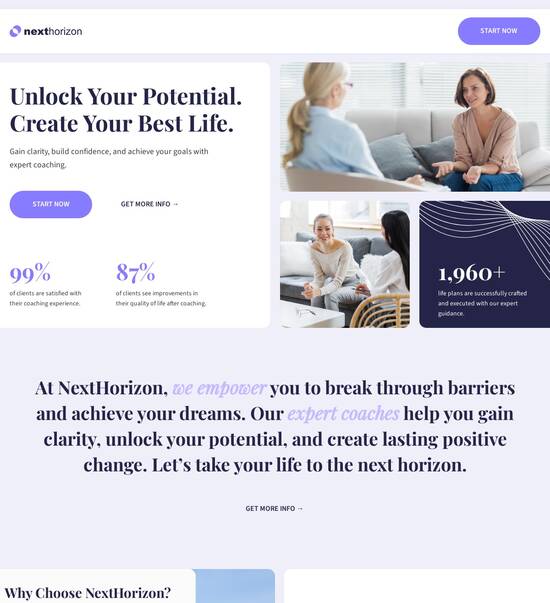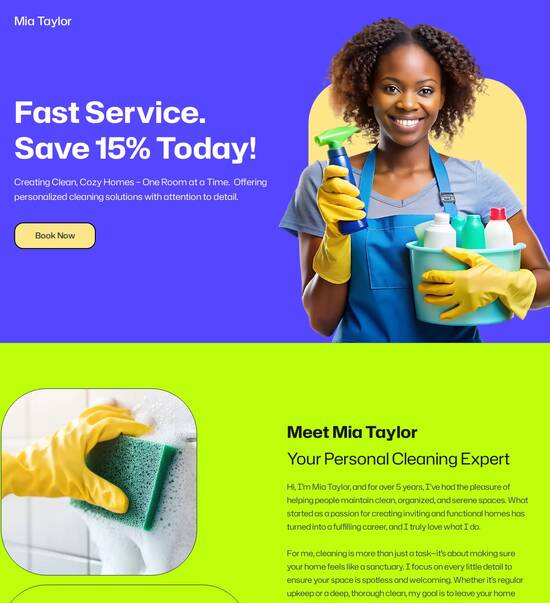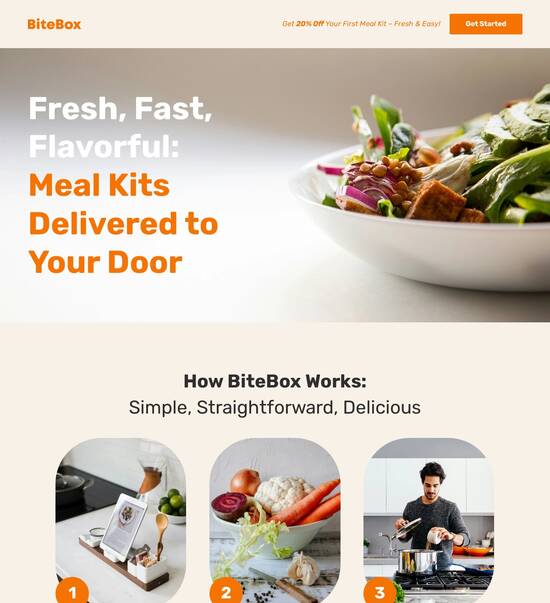
Website template for parent companies
Explore Similar TemplatesAbout template
Take advantage of Instapage's website template for parent companies
Recommended templates

Easy to build without coding
With the intuitive drag-and-drop builder, anyone on your team can create high-converting pages without any knowledge of code or design. Make enhancements to your landing page with custom widgets using Javascript, HTML/CSS, or third-party scripts.

Multiple layouts for any industry and goal
Select from 500+ landing page layouts built to boost conversions across industry-specific scenarios. Customize them by adjusting fonts, adding images, and generating on-brand content with the AI assistant. Quickly scale with Instablocks® and Global Blocks that you can save, reuse, and update globally.

Loads fast and looks polished on any device
Every template is responsive, which means they present professionally on any device and load blazingly fast with our Thor Render Engine. You can also power them up with Google AMP technology to deliver an unparalleled mobile experience and drive higher conversions.

Robust analytics & experimentation
Get real-time updates and reporting across all your devices, showing the number of visitors, conversions, cost-per-visitor, and cost-per-lead. Launch AI-powered experiments, run A/B tests, and use heatmaps to analyze user behavior, then optimize your landing page to maximize conversions.







Easy to build without coding
With the intuitive drag-and-drop builder, anyone on your team can create high-converting pages without any knowledge of code or design. Make enhancements to your landing page with custom widgets using Javascript, HTML/CSS, or third-party scripts.
Multiple layouts for any industry and goal
Select from 500+ landing page layouts built to boost conversions across industry-specific scenarios. Customize them by adjusting fonts, adding images, and generating on-brand content with the AI assistant. Quickly scale with Instablocks® and Global Blocks that you can save, reuse, and update globally.
Loads fast and looks polished on any device
Every template is responsive, which means they present professionally on any device and load blazingly fast with our Thor Render Engine.
Robust analytics & experimentation
Get real-time updates and reporting across all your devices, showing the number of visitors, conversions, cost-per-visitor, and cost-per-lead. Launch AI-powered experiments, run A/B tests, and use heatmaps to analyze user behavior, then optimize your landing page to maximize conversions.
All the features you need to build lead-generating landing pages
Explore more featuresLearn how to build top-performing landing pages for any goal
FAQs
Leading the way in building high-performing landing pages





A comprehensive guide to using Instapage for landing page optimization
Instapage stands out as the most powerful landing page and conversion rate optimization (CRO) platform available. With its robust features tailored specifically for marketers in diverse sectors, Instapage empowers teams to rapidly create, test, and optimize landing pages, maximizing the ROI of digital marketing campaigns across the USA.
Understanding landing page optimization
Landing page optimization is critical to capturing leads and ensuring that marketing efforts translate into tangible results. Instapage's flexible platform allows marketers to build landing pages quickly and efficiently. The extensive library of over 100 conversion-focused templates means there’s no need to start from scratch.
- Customization capabilities allow teams to tailor pages for specific campaigns and audiences, enhancing user experience.
- Built-in analytics tools provide insights into page performance, helping identify what works and what needs improvement.
- A/B testing features allow marketers to experiment with different designs, content, and layouts for optimizing conversion rates.
Creating effective landing pages with Instapage
To get started with Instapage, follow these simple steps: first, choose a template that aligns with your marketing objectives. Next, utilize the intuitive drag-and-drop page builder to customize your page. Finally, integrate lead generation elements to ensure you capture visitor information effectively.
- Select a high-converting template that resonates with your audience's interests.
- Personalize the landing page content to address the specific needs and preferences of your target demographic.
- Incorporate strong call-to-action (CTA) buttons that are strategically placed to guide visitors toward conversion.
Optimizing landing pages for conversions
Once your landing page is live, it's vital to continuously monitor performance. Heatmaps provided by Instapage offer valuable insights into user behavior, indicating which parts of your page attract the most attention. This data can guide further optimizations.
- Utilize heatmaps to visualize user engagement and adjust layout accordingly.
- Conduct regular A/B tests to compare page variations and pinpoint the most effective elements.
- Access detailed analytics to track conversions, bounce rates, and overall engagement metrics.
By utilizing Instapage’s features effectively, marketers can ensure their landing pages are not only functional but equipped to drive significant business results.
Start leveraging the full potential of Instapage today to elevate your marketing campaigns and improve your ROI.
Ready to optimize your digital marketing efforts? Discover how Instapage can transform your landing page strategy.
People also ask about Website template for parent companies
Website template for parent companies: Unifying brands through effective design
Understanding the concept of parent company websites
A parent company plays a pivotal role in the business landscape by establishing governance and support for its subsidiary brands. Typically defined as a corporation that owns enough voting stock in another company to control its policies and oversee management, parent companies are integral to maintaining brand cohesion and strategic direction among their franchises. Their significance can be seen in how they orchestrate resources, share technological advancements, and enhance overall productivity.
Effective website design stands central to the mission of parent companies. A cohesive branding strategy across multiple websites fosters recognition and builds trust among consumers. From a user experience (UX) perspective, it is imperative for parent company websites to present a seamless journey for visitors navigating between subsidiary brands. This holistic approach not only bolsters brand loyalty but also facilitates easier access to information across various touchpoints.
The role of website templates in streamlining design
Website templates are pre-designed frameworks that serve as blueprints for creating various types of websites. For parent companies, these templates are particularly beneficial as they help maintain consistency in visual design and function across subsidiary sites. From simple landing pages to complex multi-page sites, templates allow for a variety of customization options while preserving uniform branding elements.
Using templates offers several advantages for large organizations managing multiple brands. First, they ensure consistency in design and branding, making it easier for users to identify and trust the parent brand. Second, adopting templates saves significant time in the development process, allowing teams to focus on content and strategy rather than starting from scratch. Finally, templates can provide cost efficiencies, potentially lowering the overall expenditure in website development and maintenance.
Features to look for in a parent company website template
When selecting a website template for a parent company, customization capabilities should be a top priority. Personalization capabilities allow brands to adjust templates to better match their unique identities, while standardization ensures brand unity throughout subsidiary sites. Companies should investigate modular features that provide flexibility, which will enable teams to add or remove elements as needed.
Additionally, templates must facilitate multisite management. This means having features that enable easy control over multiple brands under one parent company, allowing for streamlined updates and consistent messaging. Responsive design is another crucial feature. With the increasing use of mobile devices, ensuring that websites are optimized for various screen sizes is essential. Important responsive design elements include fluid grid layouts, flexible images, and media queries that adapt according to device capabilities.
Customization capabilities that align with brand identity.
Support for multisite management to streamline updates.
Responsive design for optimal user experience on mobile devices.
Built-in integration with analytics tools for performance tracking.
Inspirations from successful parent company websites
Analyzing successful parent companies reveals best practices in web strategies. Brands such as Procter & Gamble and Unilever showcase effective integrations of multiple subsidiaries under one digital umbrella. These companies demonstrate how cohesive designs and strategic use of templates can enhance user navigation between brands and foster a unified customer experience. By focusing on accessible layouts and consistent branding elements, these organizations ensure that each subsidiary site successfully reflects its unique identity while still resonating with the parent company’s visual ethos.
Effective designs feature striking layouts, intuitive navigation systems, and clearly defined calls to action that guide users through the website. Visual cues such as color schemes, typography, and imagery play a vital role, creating a memorable digital experience. Additionally, innovative features, such as integrated chat support and interactive elements, enhance user engagement, solidifying the brand’s commitment to customer service and satisfaction.
Cohesive branding across all subsidiary sites.
User-friendly navigation that guides visitors seamlessly.
Visually appealing layouts that engage users.
Innovative features like chat support for improved customer interaction.
Curating a collection of website templates for parent companies
When selecting website templates for parent companies, it’s crucial to consider diverse options. The aesthetic of a template—ranging from modern to classic—can significantly affect user perceptions. Options should include minimalist styles that focus on simplicity and functionality as well as more complex layouts that can handle a wealth of content without overwhelming the visitors. Brands must choose templates that not only capture their essence but also appeal to their target audience.
Reviews from template providers can help organizations understand what works best for their needs. Critical evaluation criteria for these templates should include functionality, customization options, responsiveness, and overall design quality. Notable providers of parent company website templates include ThemeForest and TemplateMonster, which offer extensive libraries of customizable options. Ultimately, the goal is tailoring these templates to fit a brand's unique identity across various platforms and industries.
Modern design themes for a contemporary feel.
Classic themes that resonate with traditional branding.
Minimalist layouts that prioritize user experience.
Complex structures for extensive content spaces.
Building and optimizing parent company websites
Implementing a parent company website involves a systematic approach. Initially, organizations should focus on setting up the basics: domain configuration, hosting selection, and primary layout selection through chosen templates. Once these elements are in place, the customization process can commence. A detailed guide should include clear instructions on modifying templates, such as changing colors, font styles, and adding specific branding assets to align with the company’s visual identity.
Creating landing pages for subsidiary brands also demands special attention. Strategic call-to-action placements are vital for driving conversions. Additionally, developing content-specific landing pages tailored to target demographics can enhance user engagement. Regularly optimizing the website through fresh content and updates keeps the site relevant; user feedback can also inform enhancements and dive deeper into usability testing to refine user journeys.
Initial setup tips for domain and hosting configurations.
Step-by-step customization guide for templates.
Considerations for developing landing pages.
Strategies for continuous optimization and updates.
The future of parent company websites and templates
As technology advances, so do the design and functionality of websites for parent companies. Emerging trends include increased adoption of artificial intelligence to enhance user experiences, as well as a movement toward fully responsive and interactive designs. Businesses will need to adapt their strategies to maintain relevancy within the evolving digital landscape. Innovative features, such as real-time personalization and adaptive content management systems, will shape the future of parent company websites.
Templates will continue to play a significant role in this evolution. Effective templates must remain flexible to adapt to changing layouts and technologies. As businesses invest in future-proofing their web presence, incorporating features that allow for scalability and integration with advanced analytics tools will be essential. This way, parent companies can maintain oversight of their subsidiaries while continually enhancing user experiences across all digital platforms.
Conclusion: Unifying brands through effective design
In summary, understanding the dynamics of parent company websites and their importance is essential in today’s interconnected business landscape. Choosing the right website template allows organizations to unify branding, streamline processes, and deliver a seamless customer experience. Strategic design decisions not only enhance brand visibility but also foster greater trust among consumers.
Looking ahead, parent companies can embrace innovative approaches and technologies to maintain competitive branding strategies in the digital realm. By focusing on cohesive design and effective templates, businesses can create a unified digital presence that resonates with their target audiences and maximizes engagement. The future of parent company websites lies in fostering connections, both between subsidiaries and with consumers, to enrich the overall brand experience.
Ready to skyrocket conversions?
Supercharge your ad campaigns with high-performing landing pages
Get started














